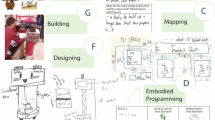Abstract
More than 200 middle school and high school students from underserved urban communities in Boston, Lowell, and Lawrence, Massachusetts, participated in after-school and summer enrichment programs over a three-year period, using hands-on learning materials and web resources to complete hands-on microcontroller-based projects. Program content was based on a suite of robotics and electronics kits developed by the University of Massachusetts Lowell and Machine Science Inc., together with on-line instructions, a web-based programming tool, and a shared electronic portfolio of student projects. Participating students worked with classroom teachers and undergraduate mentors to complete a series of projects, and took part each year in a non-competitive robotics exhibition and a competitive robot sumo tournament. Goodman Research Group assessed learning outcomes and attitudinal changes using a variety of measures, including observations of program sessions, group interviews with participating students, pre- and post-program student surveys, and educator feedback. The program was found to effectively engage participants, give them real engineering and programming skills, improve their attitudes toward science, technology, engineering, and mathematics (STEM) subjects, and increase their interest in STEM career pathways. These results are presented, along with lessons learned from the program implementation, technology development, and evaluation.
Similar content being viewed by others
Explore related subjects
Discover the latest articles, news and stories from top researchers in related subjects.References
Baker, D. (2009). Design camp: an alternative model for D&T education? D&T Practice. URL www.data.org.uk.
Eisenberg, M., & Eisenberg, A. N. (1998). Shop class for the next millennium: education through computer-enriched handicrafts. Journal of Interactive Media in Education, 98(8). URL www-jime.open.ac.uk/98/8.
Kafai, Y., Peppler, K., & Chapman, R. (2009). The computer clubhouse: constructionism and creativity in youth communities. Teachers College Press, New York.
Martin, F. G. (1996). Ideal and real systems: a study of notions of control in undergraduates who design robots. In Y. Kafai & M. Resnick (Eds.), Constructionism in practice: designing, thinking, and learning in a digital world. Mahwah: Lawrence Erlbaum Associates.
Martin, F., & Resnick, M. (1993). LEGO/Logo and electronic bricks: creating a scienceland for children. In D. Ferguson (Ed.), Advanced educational technologies for mathematics and science (pp. 61–90). Berlin Heidelberg: Springer.
Martin, F., Mikhak, B., Resnick, M., Silverman, B., & Berg, R. (2000). To mindstorms and beyond: evolution of a construction kit for magical machines. In A. Druin & J. Hendler (Eds.), Robots for kids: exploring new technologies for learning (pp. 9–33). San Mateo: Morgan Kaufmann.
Miller, L., Shearer, S., & Moskal, B. (2005). Technology camp 101: stimulating middle school students interests in computing. In ASEE/IEEE frontiers in education conference, S1F–26.
Nourbakhsh, I, Crowley, K., Hamner, E., & Wilkinson, K. (2004). Formal measures of learning in a secondary school mobile robotics course. In IEEE international conference on robotics and automation (Vol. 2, pp. 1831–1836).
Nugent, G., Barker, B., Grandgenett, N., & Adamchuk, V. (2009). The use of digital manipulatives in K-12: robotics, gps/gis and programming. In ASEE/IEEE frontiers in education conference, M2H-1.
Papert, S. (1980). Mindstorms: children computers, and powerful ideas. New York: Basic Books.
Sklar, E., Eguchi, A., & Johnson, J. (2003). Robocupjunior: learning with educational robotics. In Lecture notes in computer science, RoboCup 2002: robot soccer world cup VI (pp. 238–253). Berlin: Springer.
United Way of Massachusetts Bay & Merrimack Valley (2005). Pathways to success for youth: what counts in after-school. Tech. rep., Intercultural Center for Research in Education and National Institute on Out-of-School Time. URL supportunitedway.org/asset/mars-massachusetts-after-school-research-study.
Weinberg, J. B., Pettibone, J. C., Thomas, S. L., Stephen, M. L., & Stein, C. (2007). The impact of robot projects on girls’ attitudes toward science and engineering. In Robotics science and systems (RSS) workshop on research in robots for education. URL www.roboteducation.org/rss-2007/.
Author information
Authors and Affiliations
Corresponding author
Additional information
This material is based upon work supported by the National Science Foundation under Grant Numbers DRL-0624669 and DRL-0624631.
Rights and permissions
About this article
Cite this article
Martin, F.G., Scribner-MacLean, M., Christy, S. et al. Reflections on iCODE: using web technology and hands-on projects to engage urban youth in computer science and engineering. Auton Robot 30, 265–280 (2011). https://doi.org/10.1007/s10514-011-9218-3
Received:
Accepted:
Published:
Issue Date:
DOI: https://doi.org/10.1007/s10514-011-9218-3




